Your Cloud Storage Might Have a Hidden Cost You Didn’t Know About – Egress!
The often-overlooked costs associated with cloud data egress, the process of downloading data from the cloud, can be substantial. While services like Google, Amazon, and others offer affordable storage rates, the hidden costs of retrieving data should be thoroughly understood by businesses and individuals alike. These costs can catch users off-guard, transforming an initially economical solution into an unexpectedly expensive one.
Understanding Egress and Its Impact
Egress, essentially the act of downloading data from the cloud, is often not fully disclosed by cloud providers who typically advertise low storage costs but obscure the expensive egress fees. This lack of transparency can lead to significant financial strain, especially for users who need to access large amounts of data frequently. Cloud providers usually emphasize the affordability and scalability of their storage solutions, drawing customers in with promises of low monthly fees and high availability. However, the details regarding data retrieval costs are often buried in fine print or hidden in complex pricing structures.
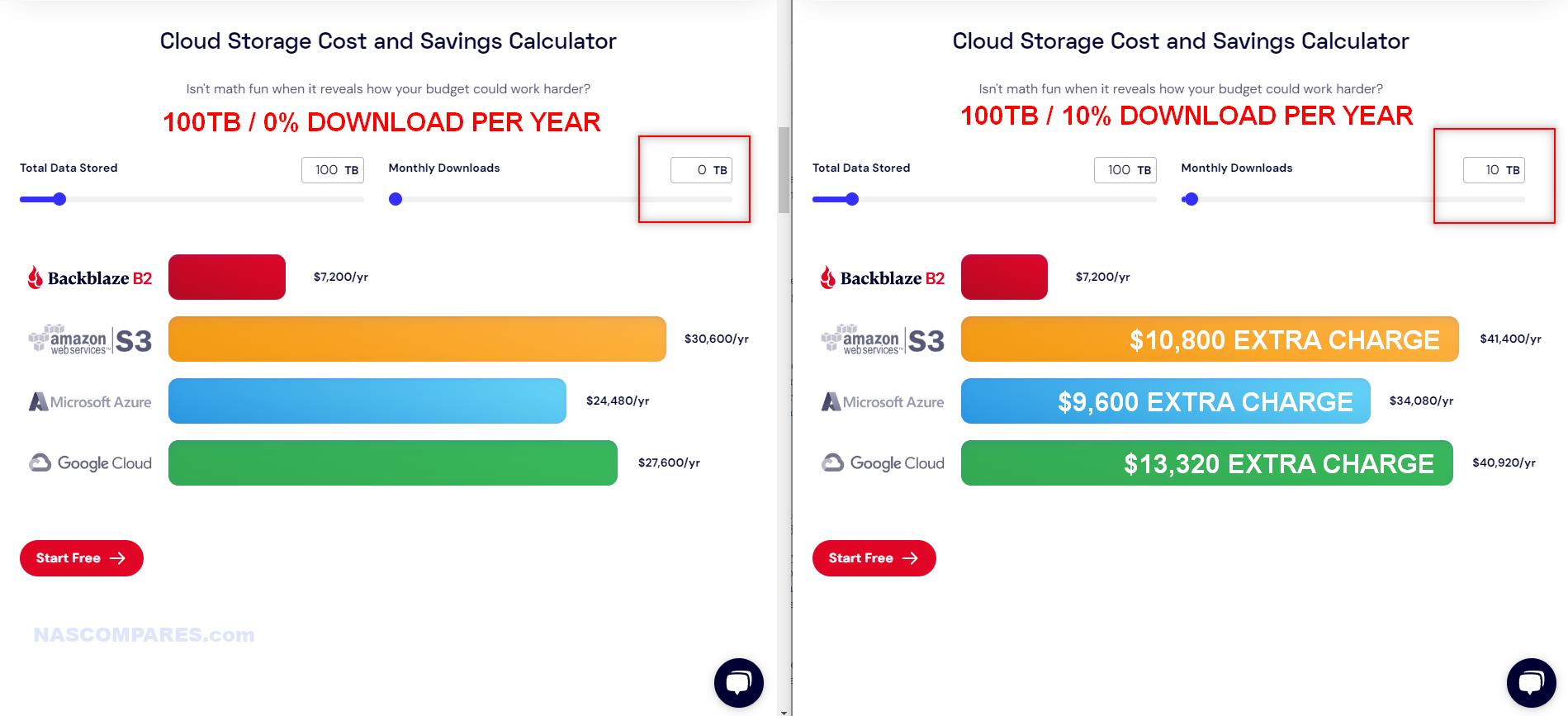
The impact of egress costs becomes evident when businesses or individuals start to retrieve their stored data. Frequent data access can quickly escalate expenses, leading to budget overruns and financial difficulties. For example, businesses that rely on cloud storage for their operational data, backups, or disaster recovery plans may find themselves paying exorbitant fees just to access their own information. This can hinder their ability to manage cash flow effectively and invest in other critical areas of their operations. Moreover, the unpredictable nature of egress costs adds another layer of complexity. Unlike fixed storage fees, which are easy to budget for, egress fees can vary widely depending on the volume of data retrieved and the frequency of access. This variability makes it challenging to forecast expenses accurately, potentially resulting in unpleasant surprises when the bills arrive. For users with high data retrieval needs, understanding the full scope of egress costs is crucial for making informed decisions about their cloud storage solutions.
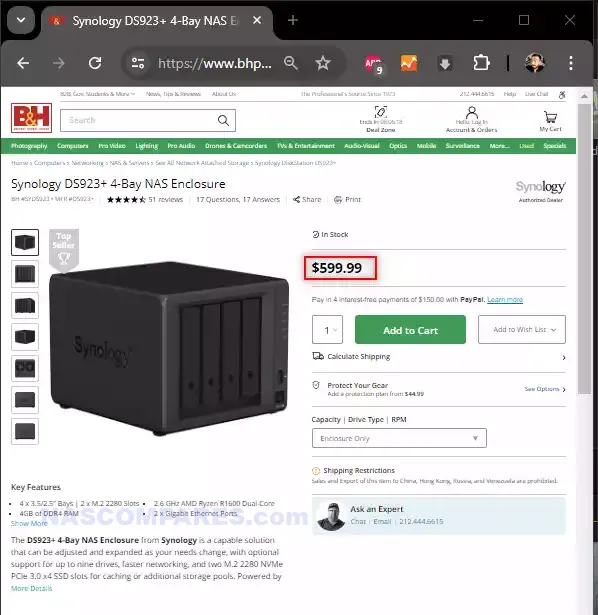 |
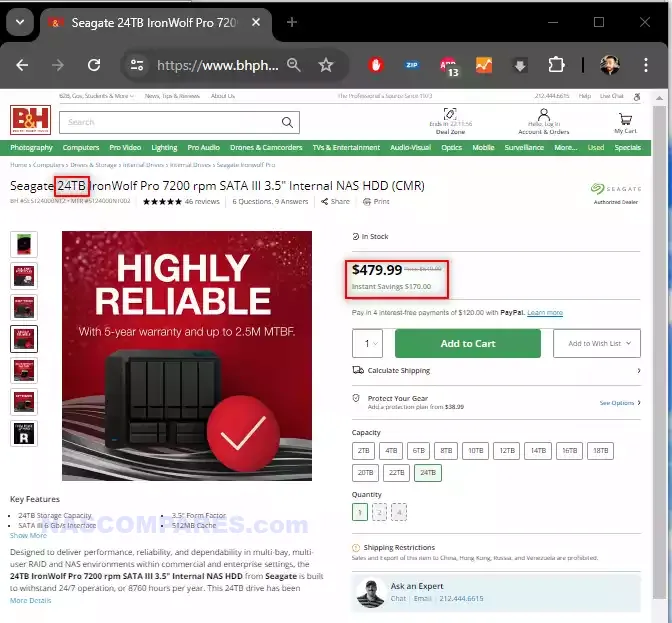 |
Egress Cost Example
Storing 20 terabytes of data in the cloud might seem economical initially. However, downloading just one terabyte per month can drastically increase costs, making cloud storage more expensive than anticipated. These egress fees can add up quickly, transforming a seemingly cost-effective storage solution into a financial burden. For instance, if a business needs to access a significant portion of its stored data regularly, the cumulative egress fees over a year can far exceed the initial savings on storage costs.
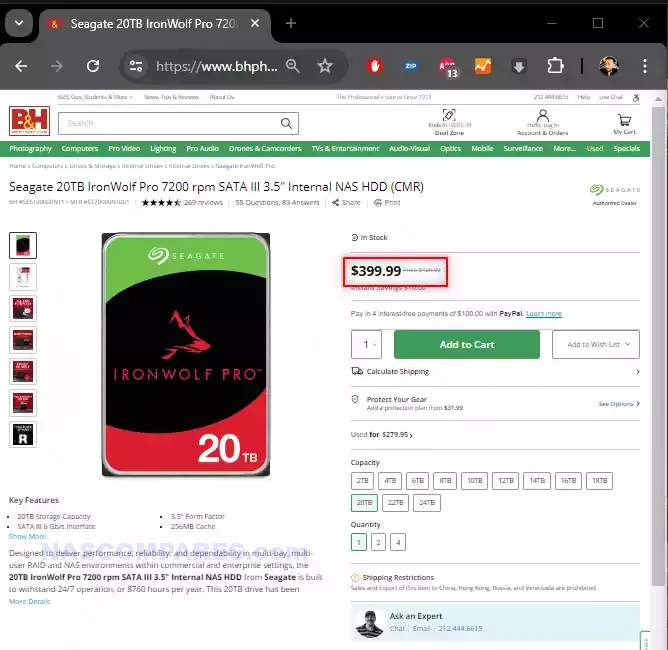
Consider a scenario where a company uses cloud storage for its customer data, project files, and backups. With 20 terabytes stored, the monthly storage fee might be manageable and within budget. However, if the company needs to retrieve 1 terabyte of data every month, the egress fees could be substantial. Assuming an average egress fee of $0.09 per gigabyte, downloading 1 terabyte (1,024 gigabytes) would cost approximately $92.16 per month. Over a year, this amounts to over $1,100, a significant addition to the company’s expenses. This example highlights the importance of not only considering storage costs but also factoring in potential egress fees when evaluating cloud storage solutions. Businesses must assess their data retrieval patterns and calculate the total cost of ownership, including both storage and egress fees, to make informed decisions. Ignoring these costs can lead to financial strain and disrupt operational budgets, especially for small and medium-sized enterprises with limited financial resources.
Business Implications
Businesses with substantial data needs or frequent data retrievals face significant egress charges. Scenarios such as backing up multiple sites, restoring data after disasters, or permanently moving data off the cloud can incur hefty costs. These unexpected expenses can strain budgets and impact financial planning, making it essential for businesses to thoroughly understand and anticipate these charges when choosing a cloud storage solution.
Highlighting Egress Issues Through Scenarios
- Multiple Office Locations: Backing up to a central cloud can incur hidden egress costs due to background data transfers and synchronization. Even routine operations can result in significant costs.
- Single Office with Multiple PCs: If a disaster occurs and all data needs to be restored, high egress costs can be incurred. This highlights the risk of depending solely on cloud storage without accounting for potential recovery costs.
- Moving Away from Cloud Storage: High costs associated with downloading all stored data within a limited time frame can be a major issue, making the transition to different storage solutions prohibitively expensive.
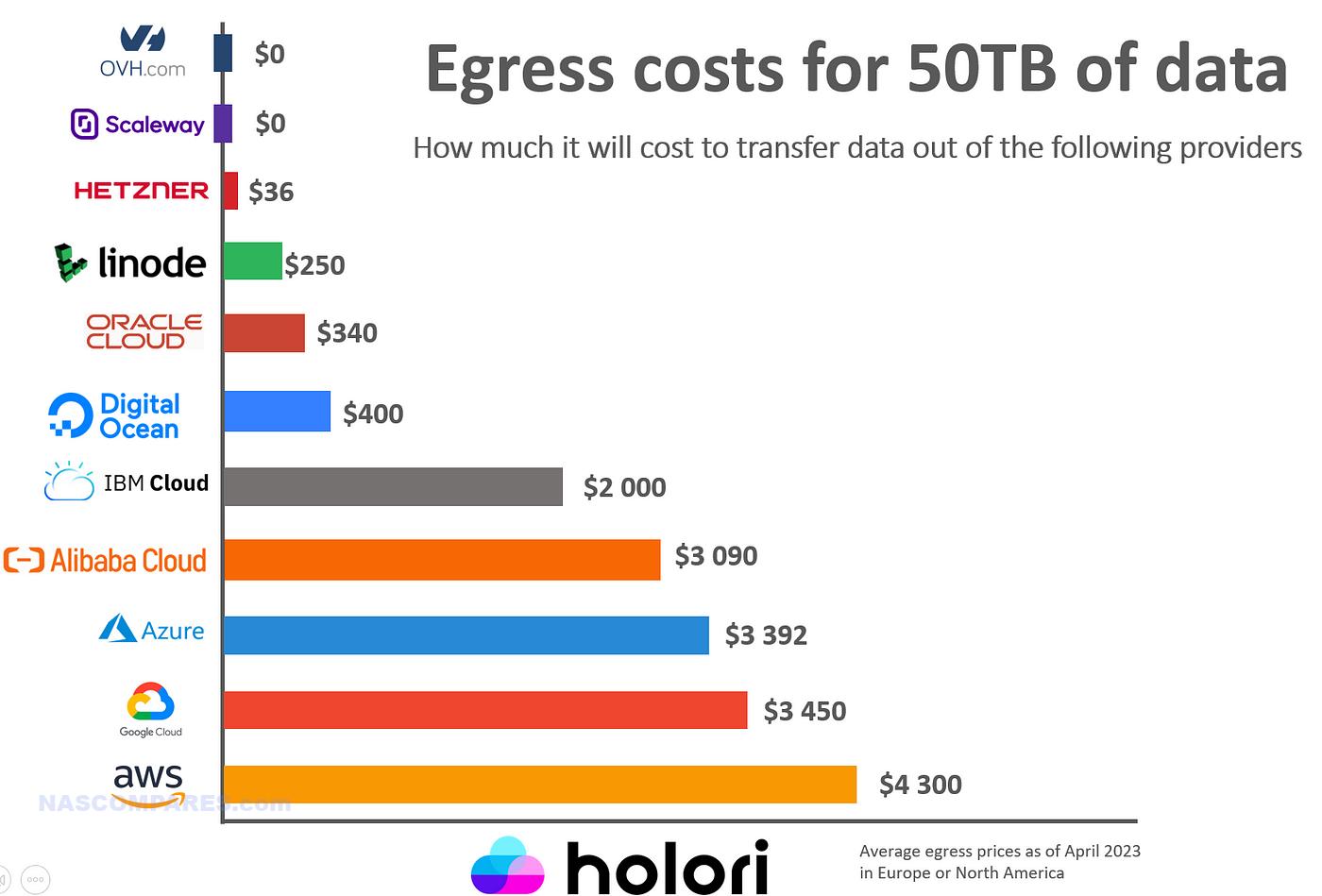
Comparing Cloud Egress Costs with Private NAS Ownership
When examining cloud storage costs versus owning a private NAS, it’s essential to consider both initial and ongoing expenses. Cloud storage services like Dropbox, Google Drive, and OneDrive often have low entry costs but can accrue significant fees over time due to egress charges. For example, Dropbox offers 2TB for £7.99/month (or £95.88/year), and Google Drive provides 2TB for £79.99/year. While these rates may seem affordable, the costs can quickly escalate when factoring in egress fees for data retrieval. This can lead to unpredictable expenses that disrupt budget planning.
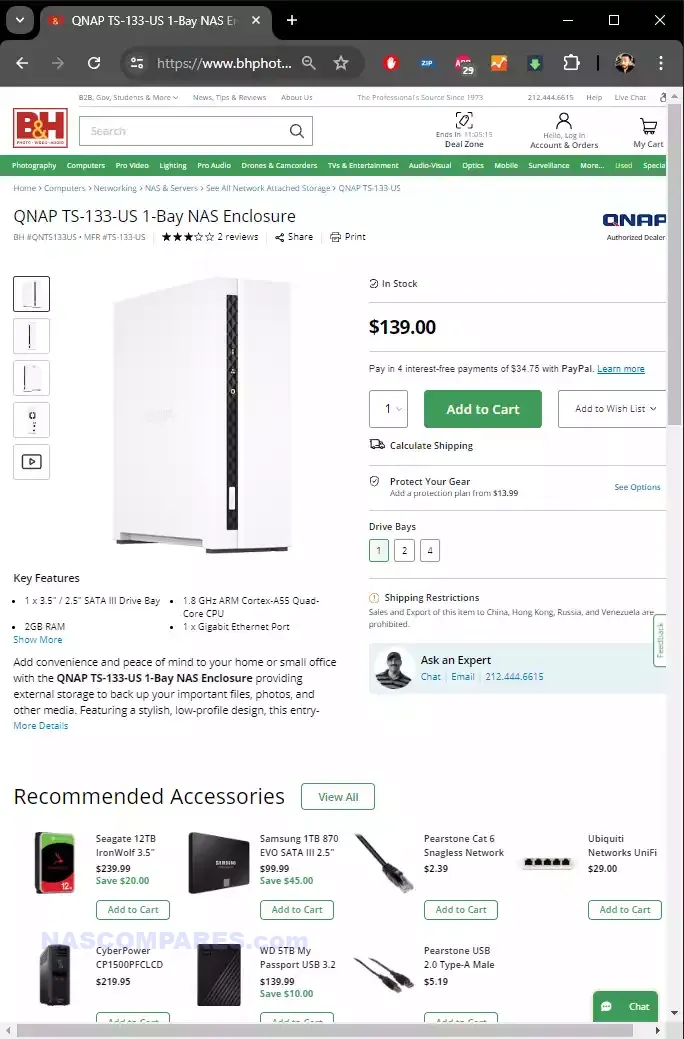 |
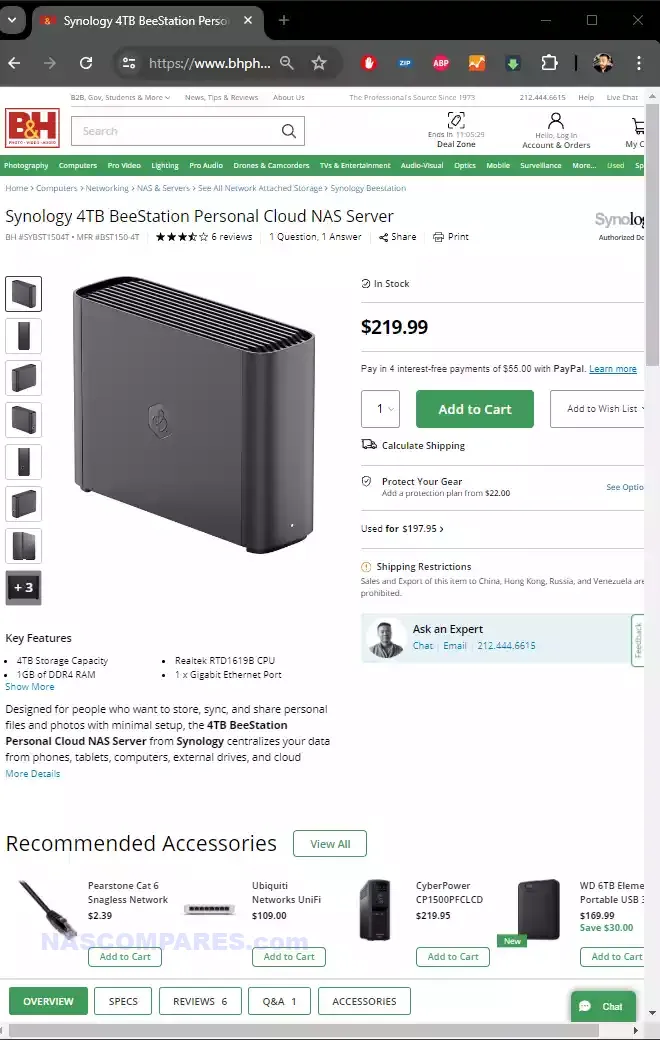 |
In contrast, investing in a NAS offers a more predictable and VERY flexible cost structure. For instance, a high end enterprise solution like the QNAP TS-H2477XU-RP NAS server is priced at approximately £5,769.59, whereas the desktop sized Synology 4TB BeeStation Personal Cloud NAS Server costs around $219.99 and included the storage. While the upfront costs for NAS equipment can be highly dependant of the scale of your business/requirements, they provide unlimited access to your data without additional retrieval fees. This makes NAS a more cost-effective solution for businesses and individuals who require frequent and extensive data access, offering better long-term value and financial predictability.
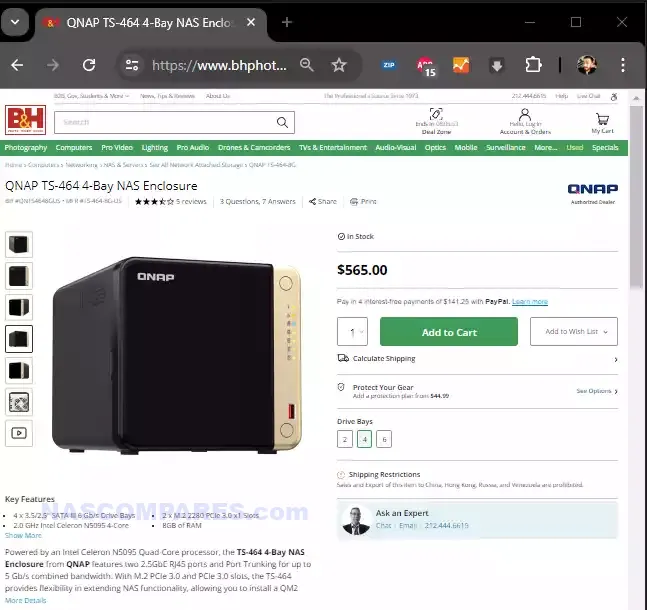 |
 |
Additionally, NAS solutions offer greater control over data management and security. Unlike cloud services that depend on third-party policies and infrastructure, NAS devices allow users to manage their data locally, ensuring it remains accessible without incurring additional costs. In recent years, the jumping off point for prosumers and smaller scale users has been 4-Bay solutions like the $550 DS923+ or the QNAP TS-464 4-Bay NAS Enclosure at $565.00. Whereas BASIC storage is still popular and affordable as just simple google drive/dropbox alternatives (such as the DS223 from Synology or the QNAP TS-233-2-Bay NAS Enclosure at $199.00 provide scalable storage solutions with no recurring egress fees. This level of control and predictability is particularly valuable for businesses with large data volumes or sensitive information, making NAS an attractive alternative to cloud storage.
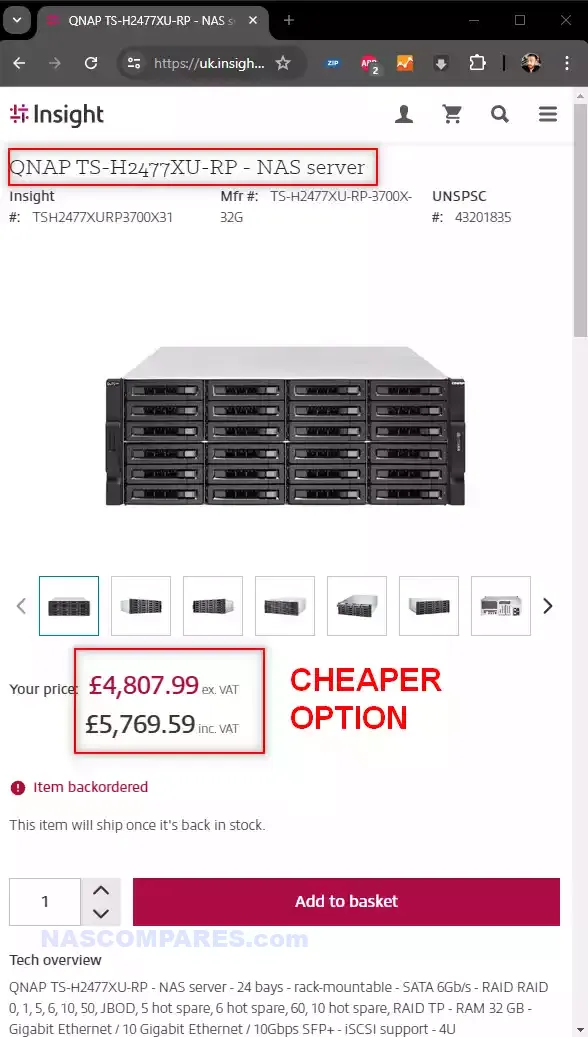 |
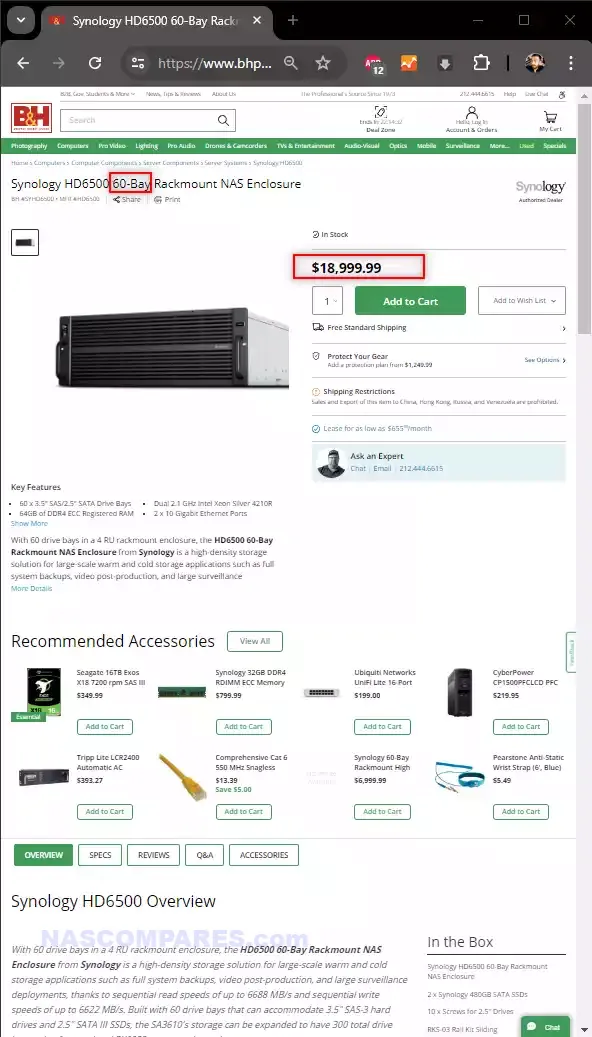 |
Performance Comparison: Cloud vs. NAS
Another significant factor to consider is performance. Cloud storage performance is often limited by the upload and download speeds at each site. This can be a bottleneck, especially in regions with slower internet connections. In contrast, NAS systems start at gigabit network speeds and can be quickly upgraded to 10GbE, 25GbE, and even 100GbE as needed. This flexibility allows NAS users to achieve much higher data transfer rates, enhancing productivity and reducing downtime.
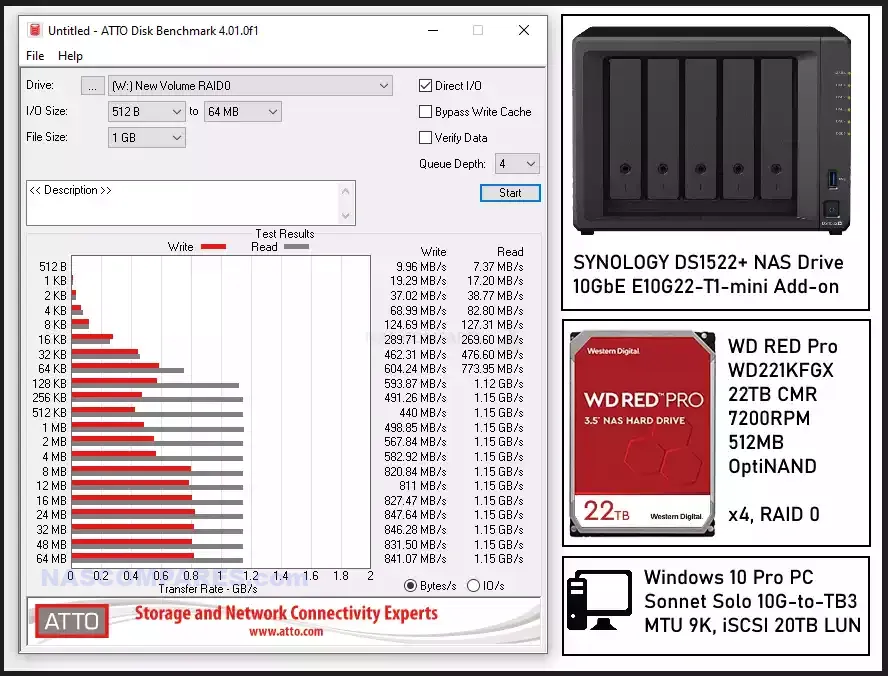
For example, the Synology DS1522+ NAS Drive with a 10GbE E10G22-T1-mini Add-on demonstrates impressive performance, capable of handling high-speed data transfers efficiently. Similarly, hard drives like the WD Red Pro 22TB and Seagate IronWolf Pro 20TB and 24TB offer robust performance metrics, as seen in their benchmark results, making them ideal for demanding NAS environments. The ability to upgrade NAS systems with high-speed network interfaces ensures that users can meet their evolving performance needs without being constrained by the limitations of their internet connection.
| Provider/Device | Storage Cost | 1 TB Download Cost | Performance |
|---|---|---|---|
| Dropbox | £7.99/month (2TB) | £0.09/GB | Limited by internet speed |
| Google Drive | £79.99/year (2TB) | £0.09/GB | Limited by internet speed |
| QNAP TS-464 NAS | $565.00 | None | Starts at 2.5gigabit, upgradeable to 10GbE |
| Synology DS1522+ | $199.00 | None | High performance with 10GbE upgrade |
ROI and TCO Considerations
Return on Investment (ROI) and Total Cost of Ownership (TCO) are critical in deciding between cloud storage and NAS:
- Cloud Storage: Low initial cost but high long-term costs due to recurring fees and egress charges. Suitable for short-term or low-volume data storage, but less cost-effective over time.
- NAS: Higher initial investment but lower long-term costs. Suitable for businesses with large or frequently accessed data, offering better ROI over time. The higher initial investment in NAS can pay off in the long run with lower operational costs and greater control over data.
| Metric | Cloud Storage | NAS |
|---|---|---|
| Initial Investment | Low | High |
| Long-term Costs | High | Low |
| ROI | Lower over time (due to recurring costs) | Higher over time (due to cost savings) |
| TCO | Higher (includes monthly and egress fees) | Lower (mainly initial and maintenance) |
Business and Personal Considerations
For businesses, the decision between cloud storage and NAS can significantly impact their operational costs. Companies with large data volumes or frequent retrieval needs will benefit from the predictable costs of NAS. Personal users, on the other hand, might find cloud storage more convenient but should still be aware of potential egress charges. It is essential for both business and personal users to consider their specific needs and usage patterns when choosing between these options, ensuring that their choice aligns with their long-term data management strategy.
Planning for the Future
For businesses and individuals considering cloud storage, it’s crucial to plan for potential egress costs. This includes understanding the provider’s egress policies and possibly integrating cloud storage as part of a multi-tier backup strategy that leverages both cloud and local storage to optimize costs and access speed.
📧 SUBSCRIBE TO OUR NEWSLETTER 🔔🔒 Join Inner Circle
Get an alert every time something gets added to this specific article!
This description contains links to Amazon. These links will take you to some of the products mentioned in today's content. As an Amazon Associate, I earn from qualifying purchases. Visit the NASCompares Deal Finder to find the best place to buy this device in your region, based on Service, Support and Reputation - Just Search for your NAS Drive in the Box Below
Need Advice on Data Storage from an Expert?
Finally, for free advice about your setup, just leave a message in the comments below here at NASCompares.com and we will get back to you. Need Help?
Where possible (and where appropriate) please provide as much information about your requirements, as then I can arrange the best answer and solution to your needs. Do not worry about your e-mail address being required, it will NOT be used in a mailing list and will NOT be used in any way other than to respond to your enquiry.
Need Help?
Where possible (and where appropriate) please provide as much information about your requirements, as then I can arrange the best answer and solution to your needs. Do not worry about your e-mail address being required, it will NOT be used in a mailing list and will NOT be used in any way other than to respond to your enquiry.

|
 |
How Much RAM Do You Need in Your NAS?
A Buyer's Guide to Travel Routers - GET IT RIGHT, FIRST TIME
Jonsbo N6 DIY NAS Case Review
The Best Bits (and Worst Bits) of NAS of 2025!
Minisforum MS-02 Ultra Review
Minisforum N5 NAS, 6 Months Later - Better, Worse, the Same?
Access content via Patreon or KO-FI
Discover more from NAS Compares
Subscribe to get the latest posts sent to your email.


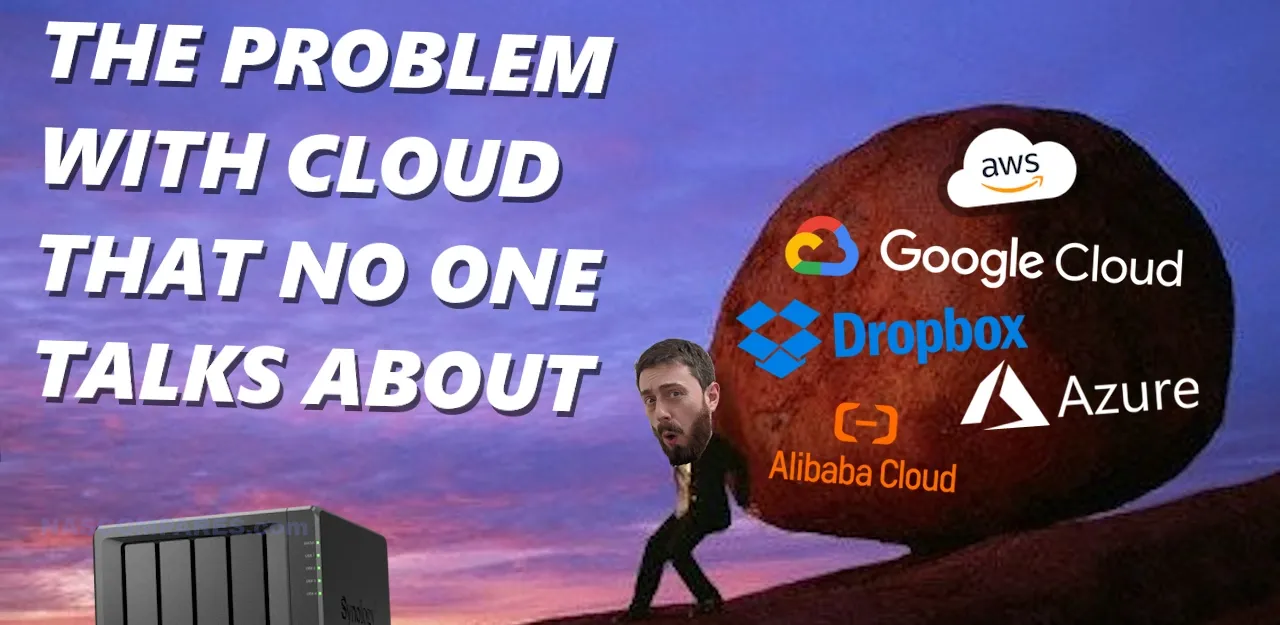
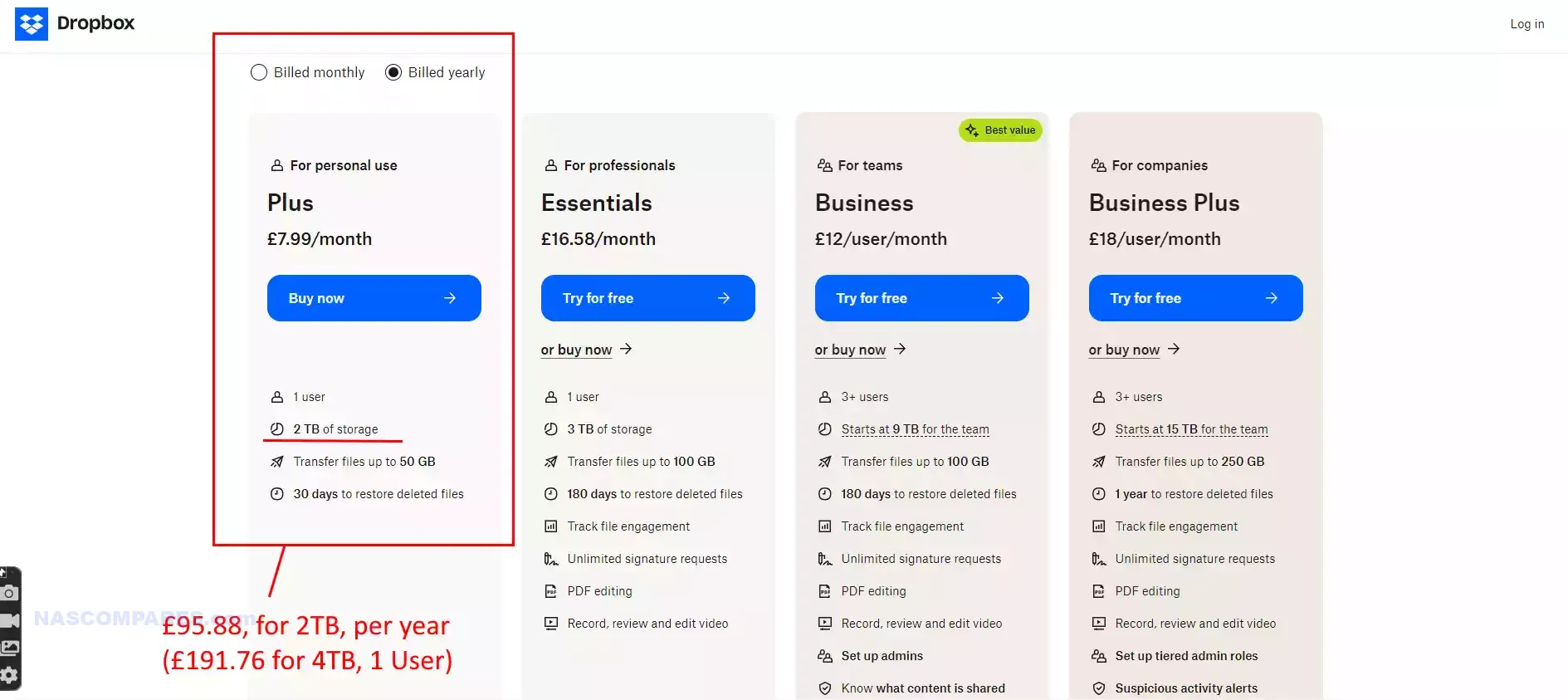

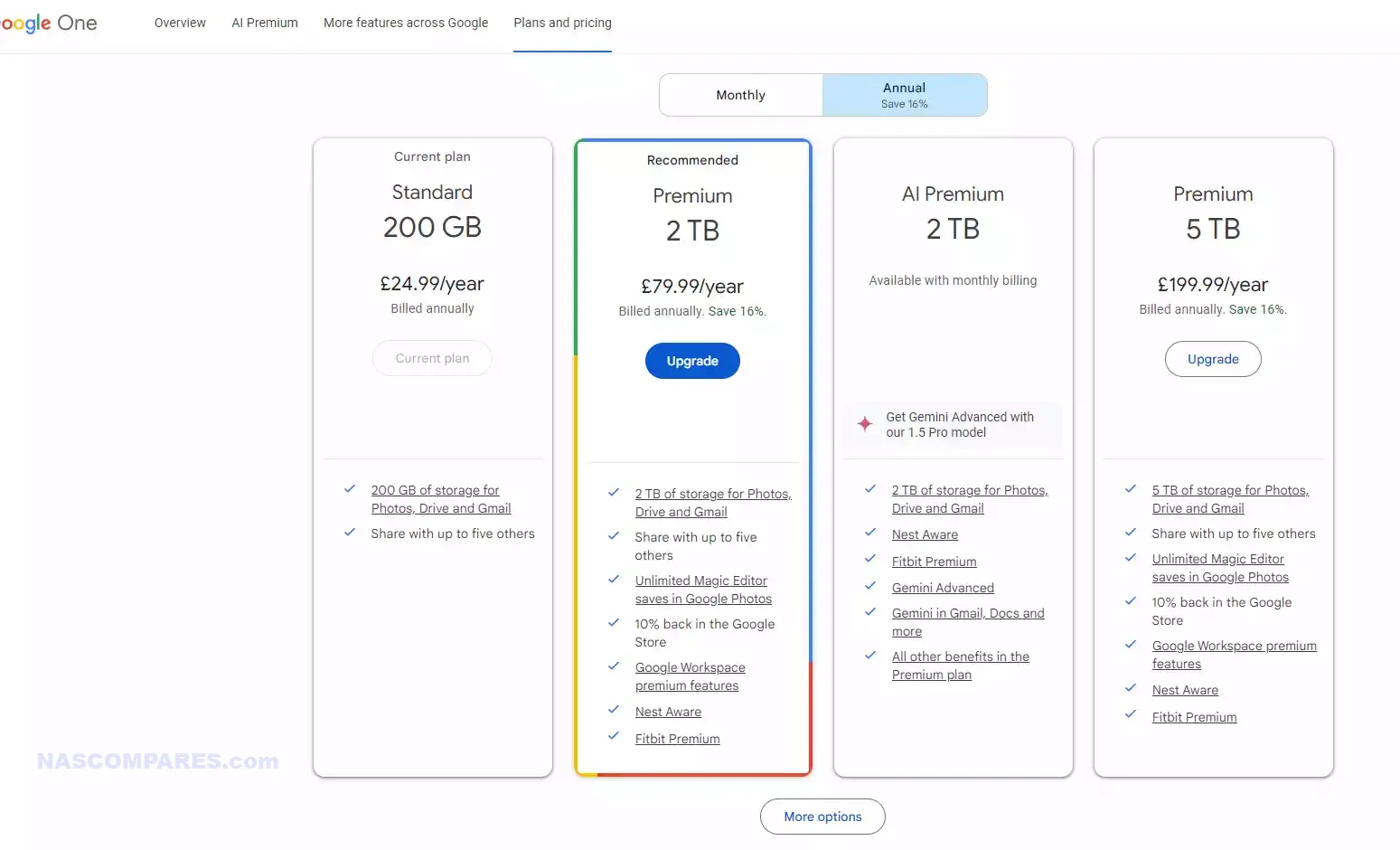



video format is incredible, so refreshing. however the camera seems to move a bit too much causing some eye strain.
REPLY ON YOUTUBE
Good on you for not pointing out the flying rats.
REPLY ON YOUTUBE
They just want to keep our data with them and make us a hostage when we need the data back. Similar issue with gdrive speed. When you upload they give you all the speed, only when you want to download the stuff back, you run into some kind of cap under a Mb/sec.
REPLY ON YOUTUBE
I have a NAS because I want to stay far away from Cloud services that cost money, but also have no interest in what I have in terms of data. Or maybe share my photos with governments or look at my data out of curiosity. That is worth a lot to me personally. Not that I have anything to hide, but because private is private, only for immediate family or friends.
REPLY ON YOUTUBE
Cloud means no administration or backup concerns. Short of World War or huge natural disaster, Cloud is pretty safe.
REPLY ON YOUTUBE
Why are you such a good speaker
REPLY ON YOUTUBE
cloud subscription services fall under the remote backup category. but what some people forget, is that you could buy a 2nd nas, install it offsite (assuming this is possible for you). Now, you got your own cloud/remote storage, but this time under your control.
However you have to self maintain, pay electricity bill for it, buy the initial hardware and any replacements for it. and also be in charge of the setup, security, updates, maintenance.
it’s cheaper than cloud subscription services in the long run.
or if your situation allows it, just a local backup between 2 nas or a nas and external usb storage would suffice. it wont have the advantage of offsite backup (u know the story of not putting both eggs in one basket).
but the advantage is the speeds will be faster, and u will have access to ur backups on hand to make maintenance easier than something that is offsite. also less complex if you don’t particularly know how to safely setup vpn for secure offsite nas backup.
REPLY ON YOUTUBE
I have around 16TB of movies on my NAS in a RAID5. What’s the cheapest/easiest (but probably cheapest) way to back the files up in case the house burns down?
REPLY ON YOUTUBE
You’ve forgot to multiply self-hosted NAS cost at least 2 times. Because you need to keep data geographically in 2 different places. At least for enterprise.
REPLY ON YOUTUBE
I was just about to get a year of Google at £79,99 and a year of Parallels to run a VM – but I was wise and got an NAS instead 🙂
REPLY ON YOUTUBE
Iron Man! U have that kid sister watch?????
REPLY ON YOUTUBE
Time to use prison wallet.
REPLY ON YOUTUBE
At 1PB level and more you are looking at an enterprise bringing in a significant revenue, where the cost of the storage is negligible. Especially considering the people who would be required to support it on premise, plus the risk you have to wear. At those levels for enterprise its not an issue. Furthermore, you are also looking at sticker price, most enterprise have specific pricing due to their spend. SMB and lower is a different story.
REPLY ON YOUTUBE
Built my own 24 bay NAS for way cheaper only using 2 bays right now but have 8 16TB drives on the way, using a second cheaper synology NAS for photos that backups the photos to the larger NAS every 24hs.
REPLY ON YOUTUBE
I’ve made the decision to sell my QNAP TS464 in favour of one drive for business. See I get OneDrive for free with my office business premium so isn’t costing me anything extra. The TS464 is great but it’s very noisy, never hibernates and is costing me money to have it running 24/7.
I am going wait a couple of years until m.2’s come down in price and go for a silent, energy efficient SSD NAS in the future. Playing the long game…..????
REPLY ON YOUTUBE
You know with cloud they have you by the balls.
People think Cloud is fail proof, but you only have to look at CloudStrike to see that isn’t the case.
REPLY ON YOUTUBE
Great video Robbie. Drop me a DM as I’d love to talk to you about how I manage multi-petabyte storage systems within my organisation and how much money we have saved over the last 10 years.
REPLY ON YOUTUBE
The biggest problem is that my large collection of kinky porns can NOT be shared up on any clouds lest any leakage might damage my good people reputation ????
REPLY ON YOUTUBE
Great video. You’ve told me exactly what I needed to know
REPLY ON YOUTUBE
You didn’t mention replacing fail components and also updating your nas to ensure it keeps getting security updates. Those costs need to be taken into account
REPLY ON YOUTUBE
main problem with cloud storage is lack of internet download/upload speeds,
although 10Gbe LAN infrastructure isn’t exactly cheap either, asking ISP for 10Gbe download+upload is a no-go
REPLY ON YOUTUBE
Apparently we’re witnessing an Alan Whicker in training ….
A reference for all the kids out there ! ????
REPLY ON YOUTUBE
It turns out that if the retailer messes up and sends you a ds420+ filled with 8tb ironwolf pro drives instead of the 89$ router that you ordered, owning a nas becomes extremely cheap! ????
(a friend of mine hates me because in his opinion I’m way too lucky, but that is just the jealousy talking ????)
REPLY ON YOUTUBE
Why do you do this in dollars when you’re in the UK?
REPLY ON YOUTUBE
Good test of your Osmo Pocket 3s face tracking. I hope the next versions has easing in and out instead of the jerky movements. Next time suggest increasing the exposure so we see more than a silhouette.
REPLY ON YOUTUBE
Cloud is called software as a service for a reason, you get a service and that’s what you pay for.
REPLY ON YOUTUBE
You are paying cloud providers so you can train their AI with your data. Not smart.
REPLY ON YOUTUBE
Cloud is just someone else’s server…
REPLY ON YOUTUBE
I was HONESTLY surprised I DIDN’T hear any seagulls. Maybe you should do MORE of your videos outside? The seagulls only seem problematic when you’re INSIDE. 😀
REPLY ON YOUTUBE
Little do we know, but he just finished battling the seagulls….
REPLY ON YOUTUBE
Same applies to compute. I previously built a global SaaS on AWS, and keeping costs down became a full time position once you get to a certain size. We had over a PB of data plus a significant amount of compute, and $20k per month was “cheap”. Eg everything was spot instances, only access data needed, make sure it doesn’t cross regions etc. Every now and then we would have a data modeller accidentally not filter data correctly or something, and poof $5k in a day. This was 4 years ago, and since then I’ve built my homelab and realized the crazy profit margins the big players are making off old hardware, never again.
REPLY ON YOUTUBE
To put my personal server in the cloud would cost me $82 a month in storage fees. That’s almost $1k a year. I can build a nice server for less than that and it will last many years.
REPLY ON YOUTUBE
As someone who has helped build data centers for a decade+, the ideal 50tb+ setup is multiple devices colocated and accessible
REPLY ON YOUTUBE
Ah yes a British beach and “surf”.
I also love the irony that he goes to the beach and there are no seagull audio, compared to his office/studio!
REPLY ON YOUTUBE
This was exactly the reason why I moved my company to a local server.
Proxmox, OMV, Keriomail and two SQL servers. Works like a charm. Relatively energy efficient.
Local backup is not a problem: Local virtual PBS server and an external server (N100) running PBS as well do the job.
Remote backup, however is a problem:
Speed, data sync, database sync, mail sync is what I should have. But miss right now. Lethal.
We work on a industrial estate with low internet speed because of the low usage density so possibilities are limited.
Maybe an interesting topic for your next video? 😉
REPLY ON YOUTUBE
stupid video
REPLY ON YOUTUBE
What is he doing in a computer game?
REPLY ON YOUTUBE
The up front cost for my NAS upgrade is going to hurt but once it’s built all I have to worry about is power and maintenance which I’m fine with. I recently helped a friend set up a ‘do it all’ server because he did the math and realized between storage and VM’s for whatever he was doing with various services he had spent more than the cost of the server over a couple years. Yes added time and effort for administration and maintenance but now it lives in his basement instead of on someone else’s servers.
That said there are situations where cloud makes sense but like you mention it’s not cheap when you are a data hoarder like me.
You can also do a 60 bay chassis a lot cheaper than synology if you don’t mind getting something like a storinator second hand, crazy as it might sound there are homelabbers out there that own them.
REPLY ON YOUTUBE
Not many people on the beach Rob, then again, as a famous local, they’re probably all at home watching your channel. I was expecting to see Eddie selling ice cream.
Very informative Rob, thank you.
REPLY ON YOUTUBE
Even if one uses cloud services for their precious data… It is not THAT expensive to have a local copy on your local NAS. Just in case.
REPLY ON YOUTUBE
Enjoyed the NASCompares outside broadcast!????
REPLY ON YOUTUBE
Leasing space in a Colo Data Center is an option for offsite storage.
A half rack or half cabinet for a Tier 1 or Tier 2 Data Center is around $500.00 a month depending on location.
You could have that equipment shipped half was across the country (and in some cases a different country depending on local and Federal government regulations and rules.)
There are some caveats for that Colo Space to check before leasing.
– What is the bandwidth limits and what costs for the bandwidth.
-If you need remote hands.
There is a cost typically charged in 15 minute increments based on a per hour charge.
Per hour costs range from $150 to over $300 per hour for remote hands.
-Do they provide a connection to your device as part of the monthly fee or do you need your own Telco circuit.
If you need your own Telco circuit expect and additional charge for the circuit from the Telco (ISP) as well as a cross connect fee from the Data Center.
Typically power is included in the price per month, however if you are installing a device that requires special power plugs or additional KWH, then expect to be charged additional monthly charges for power.
For long term off site storage due to compliance, I would look at places like Iron Mountain who special in those type of solutions.
REPLY ON YOUTUBE
Privacy, and not giving money to big tech company, is priceless.
REPLY ON YOUTUBE
Maybe a HDD Housing service is an option? Like server housing, but for HDDs only.
REPLY ON YOUTUBE
I disagree with the enterprise comparison. You should have gone for a comparison to a NetApp, Dell or IBM system. The difference in price for 1PB definitely looks great when you store it on a single server, now at least triple that cost to what the cloud providers do provide. On top of that, the pricing assumes that everything is in the most expensive cloud tier. If you would actually pick an enterprise system, with 3 different locations, with the cost of networking needed etc.. The conversation would look different. I’m not claiming your own NAS won’t win, it definitely could. Just a bit more nuance, especially when moving for the enterprise class, would have been appreciated.
REPLY ON YOUTUBE
Love the change of scenery. And this vid hits home. It took ~US$2500 maxing out my QNAP TS-664 but it’s 45TB worth of space which by now would have far undercut annual cloud costs. Buy once, cry once!
REPLY ON YOUTUBE
50TB for a SMB? Where did you got your statistics?
REPLY ON YOUTUBE
the real problem is that people are really bad at understanding their own usage patterns
almost always massively overestimating them.
even when they have logs on their current system that they could easily check lol
REPLY ON YOUTUBE
Great work for exposing the truths of cloud storage. They are worst than seegulls! Love the local…
REPLY ON YOUTUBE
I just want Synology to hurry up and come up with a decent 4/5 bay NAS that can handle Plex and family photos/files. Older models are nowhere to be found in UK and outdated already 🙁
REPLY ON YOUTUBE
Video title should be “Man that hates seagulls goes to the beach”
REPLY ON YOUTUBE
camera should not be shooting into the sun, have it between you and the sun with you facing the sun – would work much better – esp. if you have those sunglasses on 🙂
REPLY ON YOUTUBE
What are all these crazy values of money we’ve got knickers quid pesos tokens pounds shillings beans I don’t even know what most of these are
REPLY ON YOUTUBE
So you do your first video outside on the beach and THAT is the video with no seagulls. Go figure.
REPLY ON YOUTUBE
also as a business you get capex Tax allowances on Hardware But not services
REPLY ON YOUTUBE
OH NO SEAGULLS! lol
REPLY ON YOUTUBE
Yeah, if you’re only considering this as internally accessible for S3, etc then it likely doesn’t make sense, but if you have customers/public accessing it and there are millions of accesses, then it, cloud, makes a lot more sense. Creating the infrastructure to cater for that especially if one month you only need to serve 1000s, the next month millions then 1000s again is either constantly expensive, or your service collapses during one month. It’s about choosing the right service/solution for the right use case.
REPLY ON YOUTUBE
Brighton ? No shit hawks ? Edit… oops, jumps the gun on the birds. Sorry.
REPLY ON YOUTUBE
Even though there weren’t any seagulls in the video, I’m still going to say an obligatory, “I hate seagulls.”
REPLY ON YOUTUBE
What about Storj?
REPLY ON YOUTUBE
Thanks!
REPLY ON YOUTUBE
Also bear in mind when you are paying for a service, that price is going to increase over time!
REPLY ON YOUTUBE
When I looked at creating a much larger NAS than my 4 bay Synology I couldn’t believe how expensive it was to backup, even for cold storage. I had purchased a 36-bay server and initially populated it was 100TB of storage. I was able to purchase an identical backup server with another 100TB of storage with a 6 month ROI. It was a no-brainer. At work, I spend over $1bn/year on cloud and storage is usually only around 10% of our cost so it doesn’t get a huge amount of scrutiny, I was surprised there was no more competitive storage offerings so I keep it all on-prem.
Edit: that 6 month ROI was based on Backblaze pricing.
REPLY ON YOUTUBE
I completely agree with this BUT its kinda hard to tell my non techy sister or my grandma to backup using Synology Photos or guide them to configure it themselves.
Personally I think a layered tier of backups with multiple options would be applicable.
Layer 1: which includes iOS backups, Google Drive/OneDrive synced files Important documents and photos that cant be replaced. These are the files that went with you over the years. You cant repeat your 18 year old kids first birthday party can you since you lost the photos?
Layer 2: Music downloads, movies, installers, “video files” and alike. Where you can lose them and its a hassle to recover, but still recoverable.
Layer 3 is deduping layer 1: Do manual bakcups to an HDD and put it in a safe, secondary cloud backups etc.
As an IT person, I get where you’re coming from. But unfortunately I cannot self host. I lost my public IP from my ISP, I am at 100/50 down/up ratio with my internet. I dont even use my Plex server outside of my network. The only viable option for me is manual monthly/quarterly backups/syncs for all our iPhones/iPads or use whats readily availalble.
Yeah sure my household can Synology Sync their photos when at home but for families living seperately? I live most of the time out. My sibling has migrated.
At the end of the day, yes, its the best and economical choice. But everything is still a case to case basis.
REPLY ON YOUTUBE
1. Lower power options where disks are shut down. Not even started at start up, just if something is needed off that disk.
2. Options where data is moved from SSDs, to disk, disk to tape, all automatically.
3. Dual sites.
That I know is all doable.
4. Hybrid.
What if you want the best of both worlds? For example, access all over the world? Restricted access? For example collaborative working
REPLY ON YOUTUBE
You’ve convinced me…I’m going to have my barn bull dozed and put up a new air conditioned “garage” and start offering cheap space rental where people can clone their data and ship to me their servers, nas, raid, and I will hook them up providing an offsite facility with high speed internet with no bullshit frills that people don’t want or need. I’ll make money, you’ll save money. Heck I’ll even hire my redneck in-laws to guard the building with their rifles and shot guns. It will be the most secure, most inexpensive, offsite storage facility. I’m even dreaming up a design to have an enclosure where my customers can remotely have acid destroy their hardware in case they need it destroyed before any subpoenas are issued, or potentially a sealed “microwave” or “emp” enclosure. Keep an eye out for a kickstarter or go fund me in the future.
REPLY ON YOUTUBE
YOU DO NOT OWN ANYTHING ON CLOUD.
YOU OWN EVERYTHING ON YOUR NAS.
REPLY ON YOUTUBE
for selfhosting, what is the best way right now to handle secure connection to the nas for remote connection?
REPLY ON YOUTUBE
What is missing by the way, is that you also need people to maintain it, especially with larger setups. They like to get paid a salary 😉
REPLY ON YOUTUBE
You could literally build two identical NAS/Server solutions, put one offsite, provide it internet and maintain it yourself for small scale or hire a staff member to keep up with it for large scale and still have money left over from just one year of fees.
REPLY ON YOUTUBE
Lots of info and not sure if you mentioned it, but a cloud storage solution sometimes also just gets discontinued by the cloud provider, like Amazon Drive a while back. Had to reupload my cloud backup of several TB to somewhere else.
REPLY ON YOUTUBE
without even accouting for the download costs for clouds and the internet bandwidht needed to recover 10s of TB of data at reasonable speed. when you have all inhouse you have no additional hidden costs!
REPLY ON YOUTUBE
This was risky shooting the video outside! I heard there was a seagull conspiracy to drop shit bombs on Robbie 🙂
REPLY ON YOUTUBE
Cloud storage is great if your manager gets his promotion and leaves others to deal with it. It’s cheaper to keep it in house if you have an off site location to replicate it to. Clod service providers make a profit, so if you are a large enough organization, you won’t save money.
I won’t even mention that you’re giving others access to your data.
REPLY ON YOUTUBE
Not to mention when the cloud service provider uses CrowdStrike for security and you loose access to your data.
REPLY ON YOUTUBE
The costs.. wow. At the medium tier, you start seeing that buying an equivalent set of equipment could be easily affordable and you can put multiple “data centers” in multiple places. Keep data at the office, owners home, trusted employee… In less than a year you could have an AWS data center in your basements.
Going to have to talk to my wife about the cost differences and see if I can get an enterprise rack up and going for my petabyte of storage.. that i doubt i’ll ever fill but CHALLENGE ACCEPTED
REPLY ON YOUTUBE
Odd that he’s outside but no seagulls
REPLY ON YOUTUBE
This new, no studio. Nice change of pace.
REPLY ON YOUTUBE
Cloud is someone else’s profit centre
REPLY ON YOUTUBE
I get that they have to make money as a business, but that doesn’t mean f**k the customer when the need them the most (local backups lost)
REPLY ON YOUTUBE
Worse, I hate how cloud photo services like Google Photos and iCloud Photos simply remove all the original exif data and metadata from your photos once you re-download them from the cloud. I can’t believe the issue has not been fixed for years.
Imagine downloading a few GB of photos only to realise all the original dates and time are gone, now set to the data it was created after being downloaded to the device instead. EVIL.
REPLY ON YOUTUBE
In general I don’t use cloud. I think it is only viable for big companies. Middle and small will be overhelmed by the costs. Huge ones will create their own infrastructure and even sell access to it (Amazon). I think I will be forced to use that crap just to learn, but that’s it.
And in general – you cannot cheat physics and economy. Moving that amount of data back and forth must use either crazy amount of energy (which costs money) or crazy amount of time (which costs money). Data locality is the king.
REPLY ON YOUTUBE
it’s certainly worthwhile pointing out egress, as some aren’t aware.
I use BackBlaze, but 2 separate buildings would have to burn down, before I paid them for downloading my data.
REPLY ON YOUTUBE
Cloud services are designed to lock you in and make switching to a competitor (or to a self hosted solution) as difficult as possible.
That way many customers will rather keep paying for the cloud service than going through the hustle and headache of moving their data somewhere else.
Switching cloud providers should be as easy as switching your phone plan to a different provider.
REPLY ON YOUTUBE
Sorry that I could only give you a single Thumbs Up on this one.
REPLY ON YOUTUBE
the internet itself is the main issue! at best its 23.5/7 up time, with xfinity i can only dream about. only when we all have 1gb/s up and down 24/7 will could based compute / gaming / data storage become a real option for most people.
REPLY ON YOUTUBE
So what is the alternative? Building and maintaining your own 2-3 servers and placing them in collocation DCs? Do you understand this still will infer the same data transfer problems but it with much higher TCO?
REPLY ON YOUTUBE
Everything except Backblaze is just obscenely overpriced. Backblaze is just regular overpriced. As in your own setup amortizes within about 2-3 years. But Google for example, easily within 12 months including energy and all the recommended backupsystems.
Used 12 bay Server with all required hardware to operate: 430
4 non helium filles no shenanigans 10TB Enterprise disks for a ~27TB RAID5: 800
REPLY ON YOUTUBE
Please don’t make it even more dramatic than it is. From the Microsoft Azure website:
“Azure offers free egress for customers leaving Azure when taking their data out of the Azure infrastructure via the internet to switch to another cloud provider or an on-premises data center.”
However there is this, so egress cost can be a real pain, just not for leaving.
“Azure already offers the first 100 GB/month of egressed data for free to all customers in all Azure regions around the world (see Internet Egress table above). If you need to egress more than 100 GB/month, please follow these steps to claim your credit.”
REPLY ON YOUTUBE
here on planet earth….its common knowledge that clouds disappear….
REPLY ON YOUTUBE
Cloud storage pricing is not transparent. Best to have local storage
REPLY ON YOUTUBE
Does Dropbox have egress? I was just looking and can’t find any mention of it
REPLY ON YOUTUBE
The cloud for data storage or backup is a terrible idea. I’ll use high-end Samsung phones and Apple iPhones as an example. Neither of these supports microSD slots and instead asks you to use the cloud. The cloud is slower than a microSD card. It costs more in monthly payments and bandwidth charges than microSD cards. The cloud and internal memory are less secure than microSD cards (if you only carry the cards you need that day). Encryption is never as good as not giving others (FBI, NSA, local police, hackers, etc.) access to the data in the first place.
REPLY ON YOUTUBE
Very good video. It’s true that all you hear about the cloud is either from those who love it or those that hate it.
All the companies I’ve worked for always want to move to cloud but they never ever consider coming up with a back out plan in case things turn sour.
REPLY ON YOUTUBE
Seagulls are nice, but sometimes loud.
REPLY ON YOUTUBE
These are highly unreasonable costs. Thank god I built my own backup machines, two copies so two machines, using old PCs.
REPLY ON YOUTUBE
This is a small and unique to myself implementation.. I have no affiliation with either companies other than as a customer. Vultr and Backblaze have a partnership, there is no cost for data transfer between them. I run a nextcloud instance to store documents and photos (I take pictures of my sons sports teams tournaments and games), and I actually configured my Nextcloud to use S3 backend to Backblaze as primary storage, and there are no egress costs for me. Why am I saying this, well because if you are careful and do the research, you can usually find a decent VPS/hosting provider with a partnership that would allow you to reduce costs.
REPLY ON YOUTUBE
i made me nexcloud at a external provider. no egress costs at all
REPLY ON YOUTUBE
Backblaze b2 is 6$/TB/month with 3x egress per month. As a home user with less than 1TB of critical data, im very satisfied. I only mirror to it every day. Even if the place burns down, it would be free to restore it again.
REPLY ON YOUTUBE
wow you have some way out scenarios going on there……If I was in Dubai doing a video promo dont think I would be dumb enough to put all that video in the cargo hold on the plane…….fyi not everyone is a youtube creator and needs to keep around tbs tbs of data…..heres a thought….delete some stuff.
REPLY ON YOUTUBE
Thank you for this video!!
I was researching how to make a backup of my old terramaster NAS to migrate to the new zimacube100, and man the prices and structure were not that clear and as cheap that they seem to make it be ( the cloud solutions)
Ended up buying a 2nd had 10 TB hdd to make my 1ry backup and then copy everything to my new NAS
REPLY ON YOUTUBE
This video was sobering. I’ve calculated these costs, but it’s not really transparent even for those who understand IT and know what they’re looking for. The average user is unaware of these problems. Very useful and good that you explained it in a short and clear way.
REPLY ON YOUTUBE
A nas is a nas, use it as a nas.
Don’t use other apps on your nas it’s another point of failure in the aspect of security, use a nas as storage only..
REPLY ON YOUTUBE
Good points, I have been skeptical of cloud storage for years but I never considered the egress part. I know enterprises are using the cloud and getting rid of on sited data servers/storage and I have been saying it is a bad idea for a long time.
REPLY ON YOUTUBE
The backup cloud provider I use has an option where they will mail you a storage device once per year (personal account) or three times per year (business account). You can use the service to send or retrieve bulk data using express delivery. I used the service once to send them data when I first started with them.
REPLY ON YOUTUBE
And also remember that cloud is just somebody else’s computer
REPLY ON YOUTUBE
While your argument is entirely correct, your examples are rubbish (to be honest).
If you use cloudstorage to store ‘desaster recovery data’ your financial calculation
MUST foresee to at least once recover that data … or else, how will you know that
it works at all (if you never tried it). So, the cost for this cannot come as a surprise
to you. You either accepted it, when you made the decision to go for the cloud,
or your mistake already happened when you did your calculation.
If you want to leave the cloud, you do NOT cancel your contract all in a sudden.
You cancel, when you either have brought your data back home, or when this
process is on the way and the end can already be seen. What you do NOT do is
to cancel and then find out, that the remaining time of the contract is not
enough to copy back your data. The usual process would be to stop uploading
new data to the cloud and start retreiving that much data per timeunit as
your contract allows …. and then, near the end of this process, cancel the contract.
So, your video has a valid core of facts and arguments, however, your examples
aren’t well thought through.
REPLY ON YOUTUBE
An interesting calculation then is, when it becomes more cost-effective to upload some noise to increase your total stored amount of data so you can fetch more data back from the cloud per time unit (e.g. month) to recover from some massive data loss.
REPLY ON YOUTUBE
How is this different from ransomware?
REPLY ON YOUTUBE
The most insane part of this is how much money these companies actually make.
I work for a company doing System Administration for other companies from small local ones to international giants. Some years ago we started to offer cloud backup solutions for our customers as a offsite backup and currently it makes so much money that its the most money making product in our offering. Not it total ammount since we have so many service contracts and such, but in relation to how much it costs to operate and maintain compared to the money we make from it, it`s huge
REPLY ON YOUTUBE
Nice information
REPLY ON YOUTUBE
It took me more than a day to download just 180gb out of OneDrive.
REPLY ON YOUTUBE
Great video and spot on, potentially in a way that may be beyond the scope of this video. Working with Microsoft Azure for 10 years I may shine some light on this concept not limited to Microsoft Azure only but other cloud vendors as well. Cloud data egress is a small aspect of the one thing that is solely missed in many Cloud Adoption Frameworks: leaving the cloud. Great documentation and strategies are available that can help move or migrate to the cloud and use the services available not limited to storage only. Almost no documentation is available for an exit strategy. I always urge organizations to have an exit strategy available to avoid turning the cloud journey into a ‘Hotel California’ experience.
And yes, you will pay for using storage one way or another. Either by expensive storage with low egress costs (a.k.a ‘hot’ storage) or cheap storage with high egress costs (a.k.a. ‘ cold’ storage). Egress costs apply to ANY data ‘leaving’ the cloud.
Hope this helps!
REPLY ON YOUTUBE
Wasabi
REPLY ON YOUTUBE
Feels like you’re paying them to hold your data hostage. ????
REPLY ON YOUTUBE
Bezos needs to pay for his yacht somehow
REPLY ON YOUTUBE
Cloud has a lot of great merit, a major benefit being reduced TCO. At least today. The price is ability to control your own destiny. Egress charges will be a key tax for having that privilege. The only hope companies (and us peon consumers) is having effective competition. That stated, most companies could not afford or take the risks involved in transitioning their company ecosystem between clouds. Seems kind of scary actually. Soon your data will be the lever for them to make what was a cheap solution suddenly be not quite so.
REPLY ON YOUTUBE
Cloudflare does R2 – S3 compatible storage, no egress fees. 10GB / month free + $0.015 per additional GB / month. Class A operations: 1M operations / month free + $4.50 per additional million operations. Class B: 10M operations / month free + $0.36 per additional million operations
REPLY ON YOUTUBE
I’ve stopped using other people’s servers unless it’s for small stuff that goes to clients and gets deleted soon afterwards. I’d rather have multiple NASs and some HDDs secretly buried in the neighbours garden.
REPLY ON YOUTUBE
Egress speed/cost don’t mean much when you have lost all your local data. That’s why it makes much more sense to use cloud providers for backup/archive purposes only (preferably encrypted before upload). It is some sort of insurance: you store data in the cloud for cheap and you hope that you will never be needing to restore lost data from there. Amazon S3 Glacier Deep Archive storage is the paramount of this idea. Very cheap storage fee and quite expensive egress (more than that, you need to wait several days before you can download data after the request). You upload and store your backup and you will never need to restore. Or restore once i a lifetime when something serious (God forbid) happens with data (is stolen with hardware or destroyed by a disaster)
REPLY ON YOUTUBE
Bittorrent sync….
REPLY ON YOUTUBE
First 35 seconds so annoying, in the sense apparently these posts by people seem to fail to understand that a NAS is literally a server. In that a server provides some sort of service for clients. Could be acting as a file server. A web server. A cloud server. A database server. Or some or all of the above. My NAS can act as a web server, cloud server, file server, and many more applications. It’s a NAS. But it’s literally a server, it’s primary function is to provide services for a client, in my case, mainly my desktop PC. A NAS is all or partly targeted for being a file server, but as a typical NAS is running Linux, it often does more than that. Of course your video explains a lot of this. But IMO, the main point is…you don’t normally directly use your NAS in the way you would directly use your laptop, desktop, tablet, etc…because it’s a server ( in fact, I can telnet into my NAS, and for all I know, edit and compiler C++ using vi…but I don’t)
REPLY ON YOUTUBE
a real eye opener, been shopping for personal cloud storage and this was completely out of my radar…
REPLY ON YOUTUBE
This wouldn’t help everyone, but i know backblaze will fedex you a hard drive with your data for free as long as you return the drive.
REPLY ON YOUTUBE
Thanks for bringing this up.
I use freebie OneDrive to synch files between two desktops, and two Android smart devices (phone + tablet).
I would really rather not use my Synology for that, because that would involve turning on access from outside my home network, and I would really rather not do that right now.
REPLY ON YOUTUBE
Not to mention that even if you are able to download it, it often comes with some weird file organisation and document naming conventions.
REPLY ON YOUTUBE
I was all day out sailing today and when I saw seagulls it immediately popped to my mind that you hate seagulls!
REPLY ON YOUTUBE
OneDrive, Google Drive and so on can be easily configured to do one-way sync from NAS to cloud storage. Not as good as real backup, but there is no egress charge. There are obvious advantages of the cloud, like “unlimited” storage, maintenance costs and so on.
REPLY ON YOUTUBE
Try and get your photos from apple long winded but doable , thenbthere is google photos !! You get all your photos and all the exit data is dumped into a file and it’s a nightmare to get it back together. So all my photos are now apparently taken in 1970 not last week ???????????????? so annoying
REPLY ON YOUTUBE
Cloud; to me it is like blowing smoke… (pun intended)
This particular topic is about what you do not have direct control over, can, at times, bite you in the back.
Either the costs, limited abilities, sometimes even indeed sanctions to you.
To me it makes much more sense to have another NAS and use that as my cold-storage.
I see this scheme as some comparable level of leasing; you believe you are having a great deal but when you do the math in full (such as egress, indeed) you learn it will cost you a lot of money.
REPLY ON YOUTUBE
NEVER use cloud services. They charge crazy fees and your data is NOT secure, no matter what they claim. And why do that when you can have your own secure NAS, get instant access and not pay a dime. It’s a no-brainer. Always run a backup as well.
REPLY ON YOUTUBE
I watch you videos just to hear you chime in with “I hate seagulls”‘
REPLY ON YOUTUBE
Another excellent video.
REPLY ON YOUTUBE
While I personally would never save any of my private data in the cloud I do get it has a place, even a decent DIY ‘cheap’ NAS is probably going to cost as much as a few years of ‘cheap’ cloud storage. That said I’ve been in IT a long time and would rather any mistakes be my fault and localized to my NAS/LAN than trusting a cloud provider. The up front cost is higher and maintenance is all on me but I can live with that.
REPLY ON YOUTUBE
Use the buddy system , put a second nas at friend house and backup to that , and let him store his second nas at your house .
I have my backup NAS in garage about 60ft away from the house so unless it’s a massive gas explosion or if some breaks into the garage and house at the same time I should be safe .
When I went on holiday I hide my drives from the NAS , and made a copy of the stuff I could get back .
The problem with NASs is that you store I lot of junk , eg backup of laptops etc which have died years ago , or full backup of a virused machine hoping to restored it after but finish doing a nuke and start again, and stuff you have downloaded for windows xp when that was they main system in 2006.
REPLY ON YOUTUBE
The sheer amount of arguments I’ve had with people on this very subject.. 9/10 I get shot down and overruled… Until the bill comes where I sit with a smug grin on my face and a hot steaming cup of ‘told you so’ soup.
REPLY ON YOUTUBE
I bought a NAS pretty much specifically because of this, and to lower my reliance on cloud storage. The way I work is, I import photos to my MacBook Pro into the Dropbox folder, everything gets stored on Dropbox, then when I’m done with the job or run out of storage on my MacBook and don’t need to access the catalogue anymore, I go into Dropbox’s “selective sync” and remove the folder so that it’s still on Dropbox but not taking up storage on my MacBook.
So what happened when both my 1TB MacBook Pro and my 2TB Dropbox ran out of storage? Well, I couldn’t just download stuff from Dropbox and offload things to hard drives, I didn’t have enough internal storage to do that. I could have added another 1TB to Dropbox for £3.99 a month, which is a decent price, but that’s only a temporary fix. I realised what a bad idea this was to not be able to actually access all of my Dropbox files, so I got a NAS and downloaded my entire Dropbox and began archiving things on the NAS (Luckily you can download everything without fees, but it took just over 3 full days to download everything on my speed, would only take half a day on fibre though). Also it was silly that I had backups scattered around on multiple external hard drives anyway, but almost every photographer will go through this phase until they finally get a NAS .
Now I just use Dropbox as a temporary offsite backup for things I’m working on, and once I’m done with it I can archive elsewhere on the NAS and remove from Dropbox. Eventually I’m going to get a second NAS for an offsite backup at my brother’s flat, but for now keeping the most critical files on Dropbox works. This is also a big deal with the way AI is going, because all of these AI companies are running out of good quality data so they’re bound to start trying to make deals with cloud providers to get access to data. Like what Adobe has now done, what happens if Dropbox decides to update their terms to start using everyone’s photos for AI training? I’m not letting that happen, so if they do I can easily delete everything off of Dropbox, cancel my subscription, and I have it all on my NAS without having to wait days to download it all.
REPLY ON YOUTUBE
Egress < Seagulls
REPLY ON YOUTUBE
Good video
REPLY ON YOUTUBE
Cloud storage should be part of a 3-2-1 backup strategy as the final insurance against disaster recovery eg: Like Malware, fire, flood, theft , malicious act that takes out your two local copies. Even then you don’t need to restore it all in one hit to recover, prioritize the data recovery. If you are relocating to another provider then you don’t need to recover anything, upload your existing local data backup then and then delete data from the old cloud provider. Not sure to many businesses/people put all their data in the cloud, typically what is to important to lose or can’t be long term archived.
REPLY ON YOUTUBE
I recently just got into a bit of bind with my Asustor nas crapping the bed and failing to initialize, losing local access to my data. I couldn’t afford another equivalent storage solution so Asustor support could restore the data to another drive. Thankfully, I backed everything up to the cloud. I wiped the NAS and started fresh BUT because I don’t want to pay to download literally terabytes of data, I’m leaving all that data till a later time when budget allows me to grab it all back. Definitely, going to put priority on a separate NAS solution to replace the cloud backup.
REPLY ON YOUTUBE
Good that someone finally publicized this. The IT folks at my organization has joked for years that it is cheap to get data into 3rd party cloud, but getting back out will cost more than a bit. The other cost to consider is the same thing that killed the data center management concept, and that is that you don’t control the ongoing costs. It may be cheap to store your data in cloud today, but the cost increases over time are not in your control. At what point does that cost exceed what it would cost to host your data on your own hardware. Of course, then you have the egress costs at that point as well.
And none of this discusses the complexity of using cloud servers (IaaS, PaaS) and the challenges increased communication path complexity bring.
REPLY ON YOUTUBE
I am of the opinion that if your data is not on hardware that you own…. you no longer own your data.
This is just one more example.
I have what some people consider to be a MASSIVE amount of data. (35TB) Look at the costs to backup that much data.
Within a few months I would have paid for my Synology NAS (1522+ with 4x18TB drives, 2x1TB cache NvMe + 10Gbit card)
I think it only makes sense to use cloud storage for BS stuff like random memes and ‘pron’
REPLY ON YOUTUBE
If you have a family member or friend, you could set up mutual cloud storage and backups.
REPLY ON YOUTUBE
A NAS, gB internet and usenet is the way.
REPLY ON YOUTUBE
Hey Robbie, love your videos. Here’s an example for a typical home user: it is not easy to download years worth of pictures from Google Photos to local storage. You have to download in chunks of compressed files. Not very pleasant.
REPLY ON YOUTUBE
????️ 3:00 ????️
REPLY ON YOUTUBE
Cloud = Someone else’s server
REPLY ON YOUTUBE
restored a customers 50GB of data using carbonite, took over 2 effing days
not even 1MB/sec for majority of time
REPLY ON YOUTUBE
This is why I don’t use cloud. In the long run having another Synology that is remote is the more cost effective solution. Up front cost can sting but no surprises down the road.
REPLY ON YOUTUBE
set up a site to site VPN like wireguard and access your home storage from anywere
REPLY ON YOUTUBE
It just occurred to me, but how is your logo not you strangling a seagull? Get the artists on it!
REPLY ON YOUTUBE
Finally someone talking about it
REPLY ON YOUTUBE